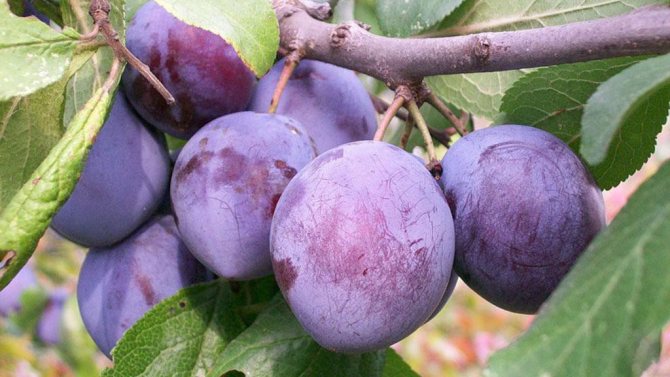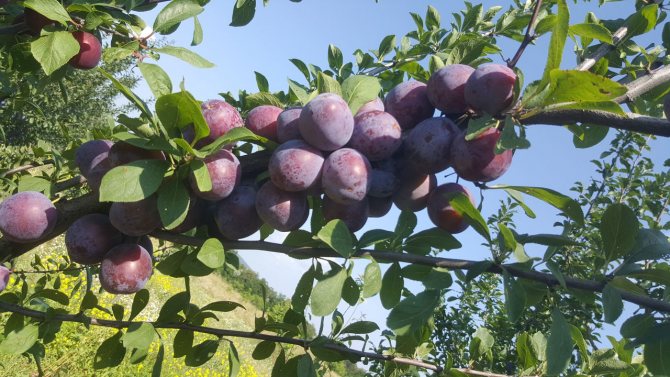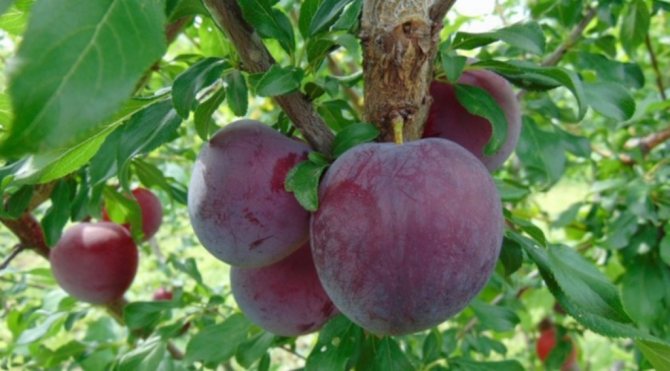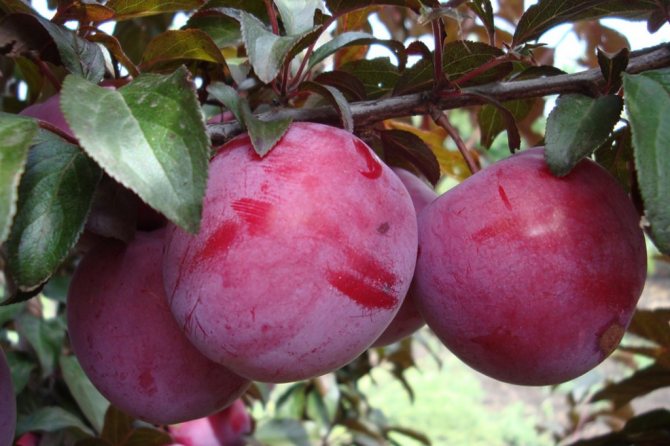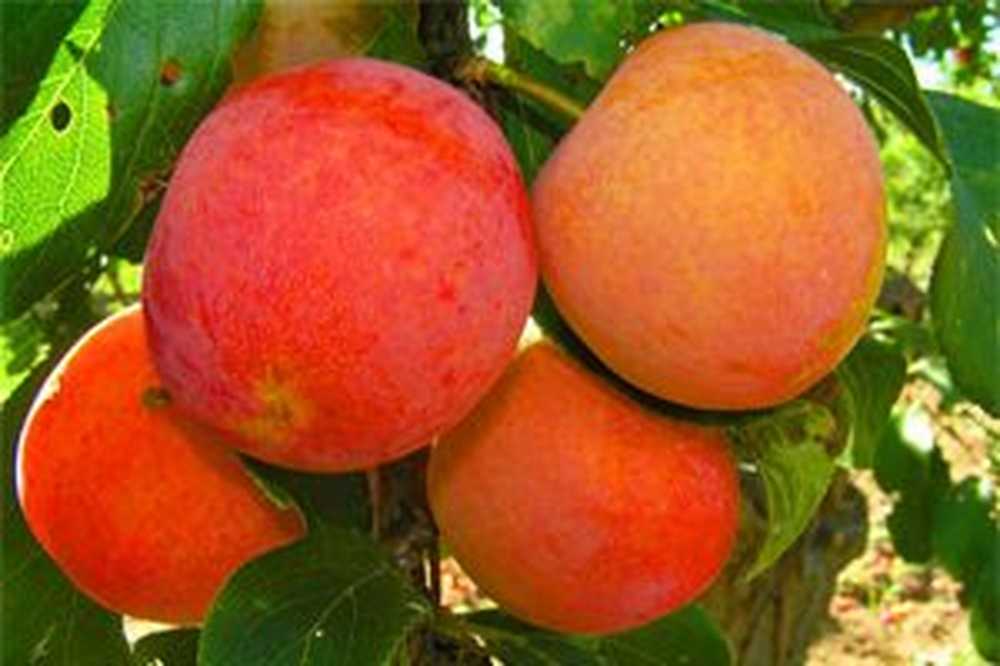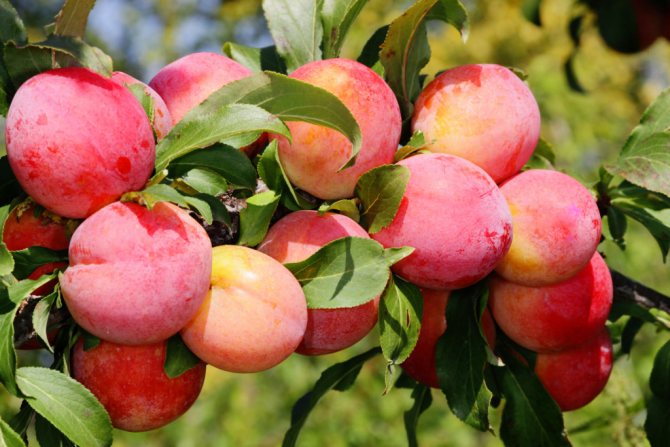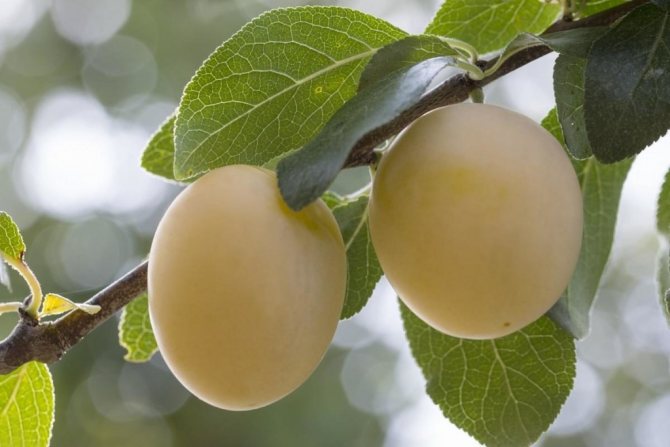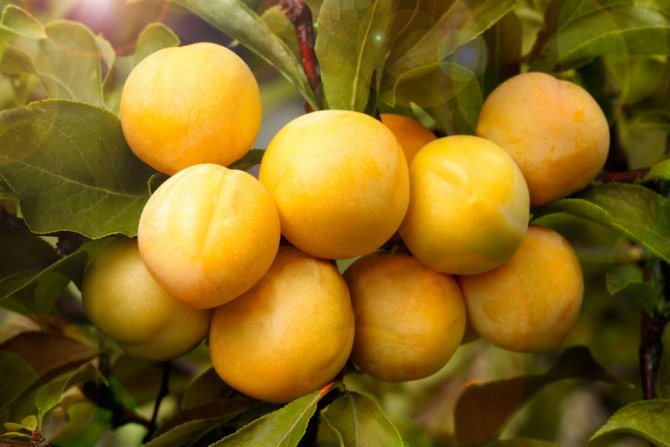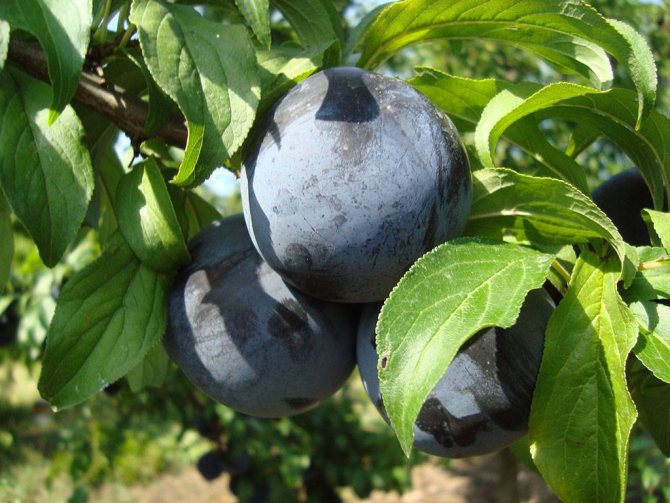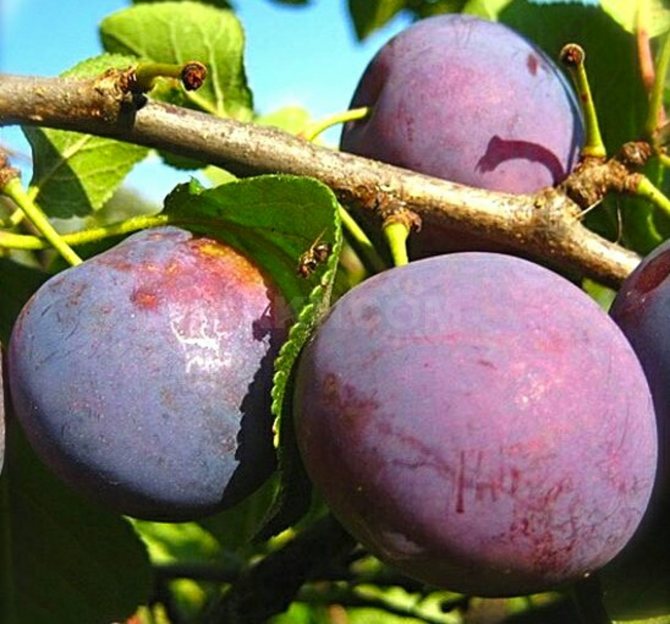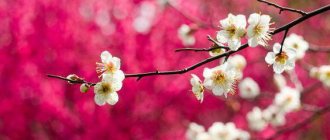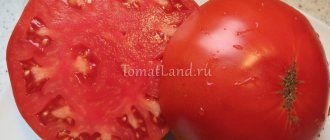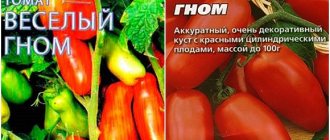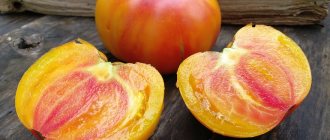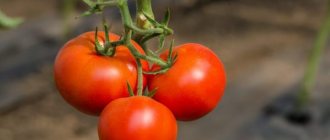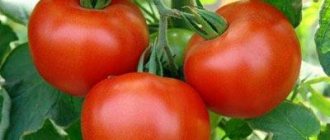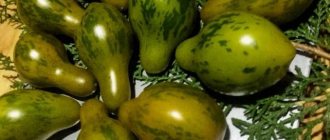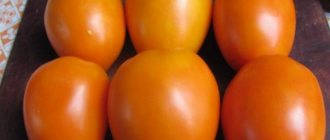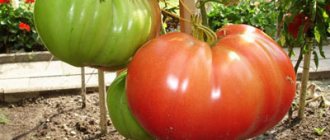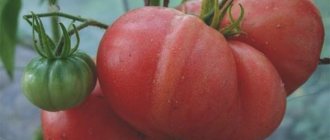It is difficult to come to a consensus about how many types of plums exist in nature. Some sources indicate an amount equal to 30, some even more than 40. This is primarily due to the fact that the formation of the plum genus continues to this day.
Culturally, plum is not at all a competitor to grapes and apricots cultivated by people since antiquity, however, in terms of human use of its species diversity and prevalence in natural conditions, it takes the lead when compared with the same and other fruit crops.
[Hide]
Types and varieties of plums
Homemade plum - a purely cultural species, domesticated on many continents. Wild seedlings of this plum by themselves cannot be found in nature, but, with the participation of humans, this is possible. Describing this species, one cannot fail to mention the versatility of the use of its fruits, which are also suitable for drying, which makes it qualitatively different from others.
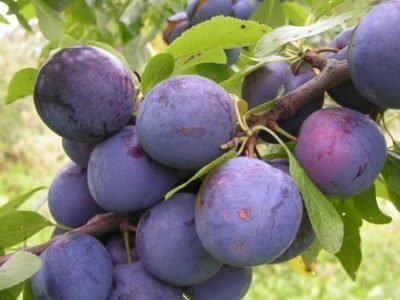
A very popular variety of homemade plums is the dessert variety plum volzhskaya a beauty with an early ripening period and large red-violet fruits (34-50 grams), covered with a dense wax coating, sour-sweet in taste. In terms of winter hardiness, the variety is in a position above the average, but in terms of drought resistance - it is high (trees are not afraid of dry weather). It is moderately susceptible to the effects of pests (rare cases of gum flow and gray rot of fruits have been recorded). Self-fertility is high, it is best pollinated by varieties of Zhiguli plums and early ripening red.
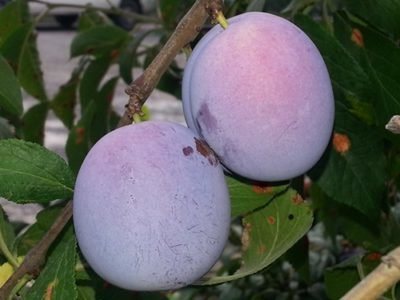

Chinese plum - a rather unusual representative of the genus from the north and southeast of China. It rises 12 meters above the surface of the earth! It has a spherical crown, gray-brown bark of trunks and spherical fruits 2.5 cm in diameter, red, yellow or green, with not pronounced wax dusting. The pulp of juicy plums has a melon aroma. It begins to bear fruit from the age of 7 years, fruits ripen in August-September. It has an average winter hardiness, the probability of sprouting is 67%.


Pissardi plum (red-leaved cherry plum)
Grows on open mountain slopes in western Asia. In decorative terms, this species is the most effective among all, standing out with a reddish shade of leaves and, which in particular attracts attention, with large pink flowers that appear before the foliage bloom and at the end of flowering acquire a dark red hue. The height of the tree is 6 meters. Fruiting profusely, the color of the fruit is dark cherry red.
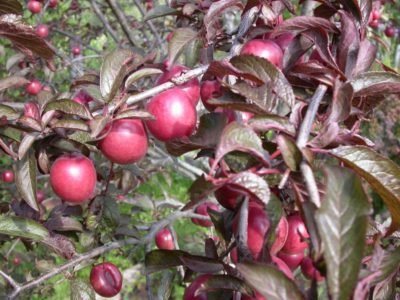

Plum varieties are usually classified according to 2 important characteristics - frost resistance and drought resistance. Frost-resistant varieties include, for example:
- early ripening, disease resistant, large-fruited variety plum Alyonushka (medium frost resistance);
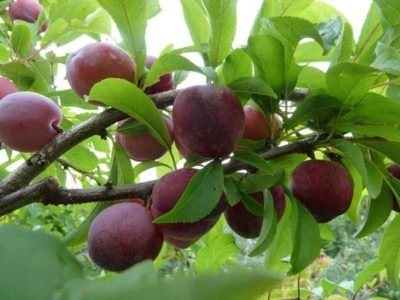

- early ripening variety plum Eurasia 21 with very tasty fruits, but poorly pollinated (high frost resistance);
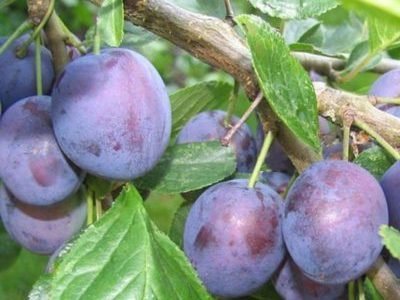

- also early, with especially tasty fruits, variety early plum (very high frost resistance).
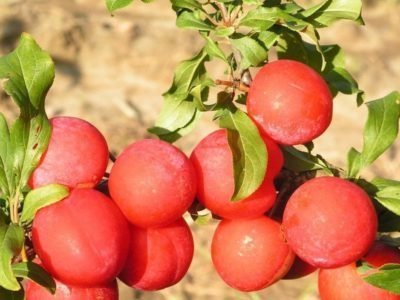

While a considerable number of plum varieties exhibit resistance to cold, drought resistance is very rare in their ranks. The palatability of the fruit does not deteriorate in drought in the following varieties:
- foreign late ripening, large-fruited, dessert variety plum Stanley (or Stanley) with oval-round fruits (relative drought resistance);
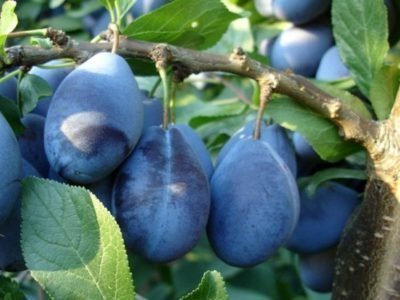

- one of the largest-fruited (fruit weight - 60-100 grams), late-ripening industrial high-yielding variety plum president with, however, not the most delicious fruits.
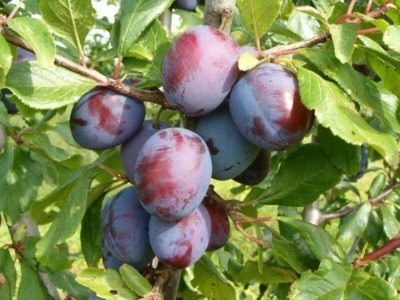

It is always necessary to take these characteristics into account when choosing a variety for growing on a site, since the above-mentioned plum is fast-growing, plum Eurasia 21, as well as plum peach Michurina, are essentially northern and in the southern regions not only do not boast of the sweetness of the fruit, but they can even lose their natural winter hardiness.
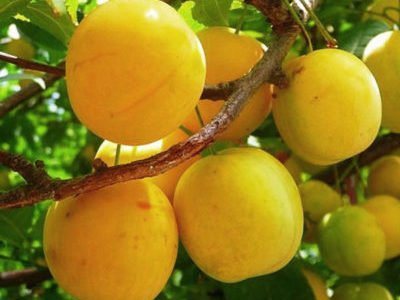

Plum renklod Altana
Traditional foreign varieties, such as plum renklod Altana, which, subject to the rules of care only once every five years, may not yield a crop, or even more stable plum hungarian azhansk with excellent-tasting fruits.
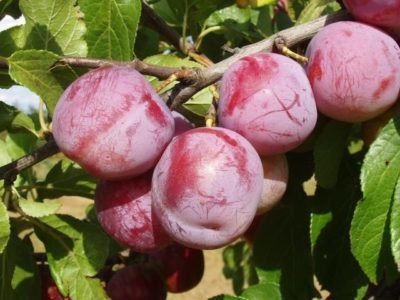

The concepts of plum that have developed in the minds of many people mean round or oval fruits with seeds, colored blue or purple. When the conversation starts to figure plum yellow, cherry plum is likely to appear in the image. But in reality, there are many yellow varieties of plums specifically (you can recall the unique Chinese plum described above - among the colors of the fruits of this type there is also yellow), and they are also different in taste and in size.
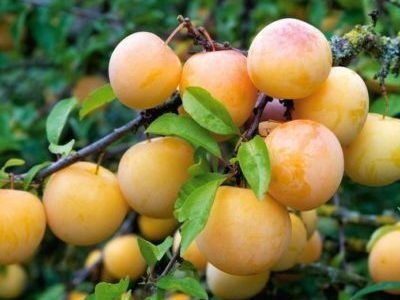

An example would be plum honey white, so named because it tastes honeyed, very sweet, but not sugary. By the way, the origin of the variety has Ukrainian roots. Differs in unpretentiousness, 30-50-gram rounded, naturally yellow fruits with a thin whitish wax coating.
It is one of the earliest ripening of all plum varieties (harvesting can begin as early as the end of July), however, at the same time, it is self-fertile and requires a pollinator, the role of which can be played by the early Hungarian plum and Karbyshev's renklod plum. The tree reaches a height of 5 meters, gives a bountiful harvest, resistant to winter.
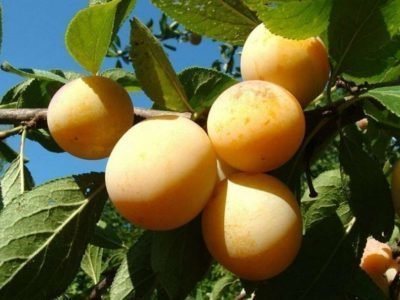

Plum yacht
Another yellow plum with a bias towards golden color - plum yacht - the main character of this article, and it is about its cultivation that will be discussed below. This hardy variety was bred by breeders Kh. V. Enikeev and SN Satarova. Positive results were achieved when crossing Eurasia 21 plum and Smolinka plum varieties. The list of its advantages is without exaggeration impressive - taking into account the general high winter hardiness, the flower buds of this plum are almost not afraid of recurrent cold snaps, plus the tree easily tolerates drought, plus it is not affected by common diseases and pests.
A powerful, actively growing tree up to 5.5 meters high enters the fruiting phase at 3-4 years of life, generously presenting the owner with a harvest from year to year. At the end of August, from one such plum, you can collect 45-50 kg of round-elongated, bright golden, sweet fruit with an invigorating sourness, weighing 25-35 grams each. However, the variety also has one small drawback - in order to get a rich harvest in a year, pollinators (partially self-fertile) are desirable, for which the Hungarian Moscow plum, the early ripening red and the memory of Timiryazev are for the Yahontova plum.
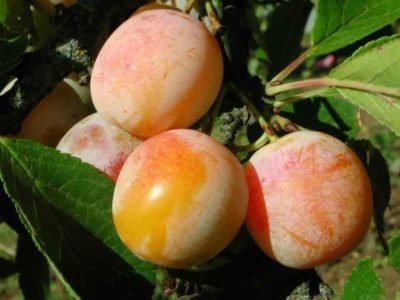

Plum sketch
It is a table variety bred on the basis of Eurasia 21 plum and Volga beauty plum, intended for technical purposes. Perfectly adapted for growing in the middle zone of the Russian Federation in small summer cottages. The height of the tree is above average, it is self-fertile. Oval-round fruits have a burgundy-lilac or reddish-purple hue with a thick wax coating and a sweet taste with a sour taste.
Begins to bear fruit at the age of 3-4 years, fruit ripening occurs in August, and is stable, annually.The etude can give up to 20 kg of harvest from a tree, and its technical purpose determines the high shelf life in the refrigerator (up to 60 days) and transportability of the harvested fruit. The variety has an increased winter hardiness of both wood and flower buds, and a relative drought resistance. As for the latter, it is worth noting an interesting fact that in hot weather its fruits acquire even greater sweetness.
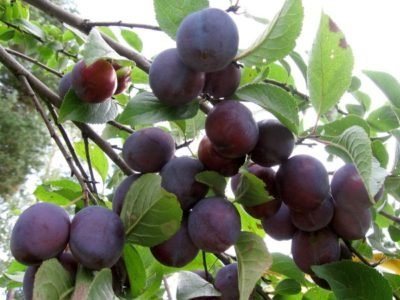

Plum candy - ultra early, early. The harvest ripens at the end of July! At the same time, the fruits are very sweet in taste and look great. Their weight is 30-35 grams, and one tree can produce up to 25 kg of plums. There is absolutely no need to put up with a low keeping quality, since the entire crop will soon be eaten.
Its decorative splendor is added to the excellent taste of the plum - the tree itself is relatively undersized (2.5 meters high) and fits into any garden exposition, decorating it first with boiling white flowers (in spring during flowering), then red-burgundy fruits with a gray coating (in summer). All this takes place to the accompaniment of openwork dark green foliage.
The frost resistance of the variety is high, as well as the resistance to diseases / pests that are standard for plums. Self-infertility presupposes the settlement of a nearby collective farm, trans-river early or columnar plum, which, by the way, will be described below.
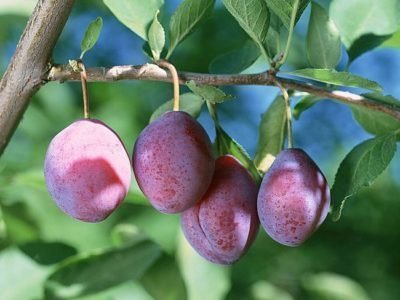

Bluefree plum
The cultivar is highly praised in North America. plum blue, which we affectionately call “supermarket dream”. He was awarded this title for the huge dimensions of the fruit - 70-75 grams. They have a dark purple color with subcutaneous punctures, very easy to transport and transportable.
It is not difficult to guess that the palatability may suffer at the same time - this is how it is, but if we take into account the agrotechnical subtleties of the variety, it turns out that this plum ripens very late (at the end of September in Krasnodar) and gains sweetness already in the last 7 days of ripening (then it becomes softer), so it is simply harvested not ripe, but with a presentation.
The yield of the variety is high, but in the conditions of the Russian Federation, it will be so only in the southern regions. It will not be superfluous to clarify that bluefri is a Stanley plum crossed with a president plum.
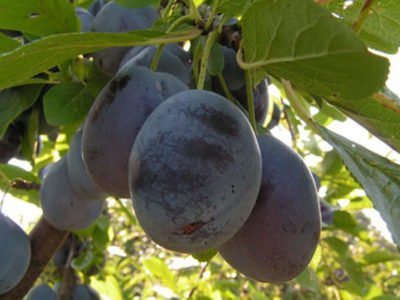

Columnar plum has become widely demanded in the CIS today, mainly due to its compactness, which greatly simplifies fruit picking and care. Such plums do not have side branches, and the ripening of the fruits occurs, respectively, on the main ones, literally covered with fruits.
The size of the tree is small, but it bears fruit excellently, providing the summer resident with 20 kg of plums annually (with proper care, of course) for 7-10 years. The advantages over other species and varieties should also include early maturity, which allows you to enjoy the harvest after only 2 years from the moment of planting. Columnar plums live for about 17 years.
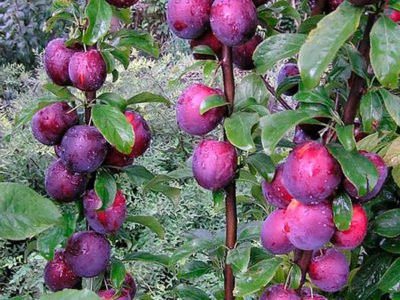

Hungarian Wanheim variety
A variety of Western European origin, self-fertile, drought-resistant, but requires well-fertilized soils.
The trees are powerful, fast-growing, have high winter hardiness, the crown is thick, wide, rounded.
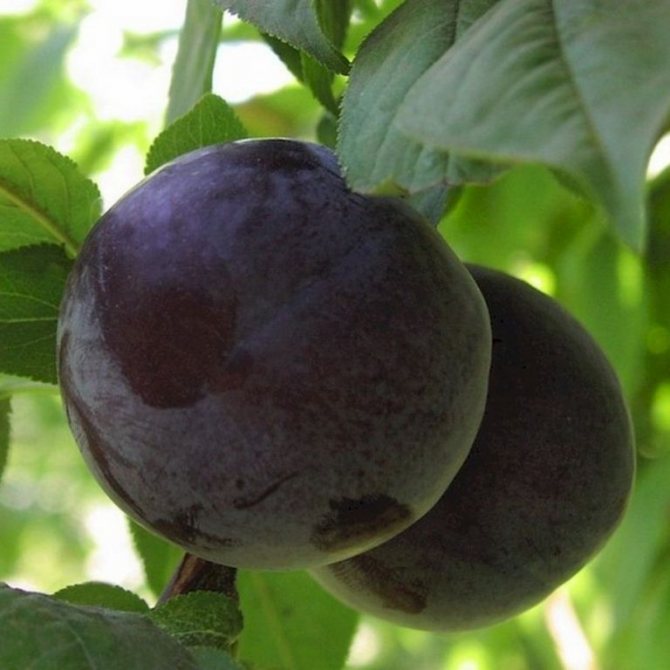

Ripening is simultaneous, in mid-August. Productivity is high, 15-20-year-old trees give up to 120 kg of fruit.
Fruits are medium, irregularly oval, with some bulge in the middle, dark blue in color; when fully ripe, they are covered with a thick waxy bloom. The skin is thin, dense, sourish, easily removed from the fruit. The pulp is dark green, dense, of pleasant taste, medium juiciness, sugary. The stone is medium, well separated from the pulp.
The fruits are suitable for fresh consumption and for processing into marmalade and jam. When dried, they give high-quality prunes, they are well transported. The variety is zoned in the Rostov region, Krasnodar Territory.
Plum planting in spring
To successfully plant plums, you need to choose early spring for the work, while the trees are still in a state of winter rest. The site should be well lit, and the groundwater should not lie higher than 1.5 meters to the surface.
The width of the landing pit is about 1 meter, the depth is 0.5 meters, it is better to prepare it a few months before disembarkation. A plum seedling with straightened roots is placed vertically in the central part of the hole, then sprinkled with turf soil mixed with mineral and organic fertilizers.
At the same time, compaction of the soil is not desirable, as is the complete filling of the root collar, which, in the optimal version, ends a few centimeters from the soil surface. At the end, mulch the trunk circle with peat or humus and water the plum well, using a couple of buckets of water per seedling.
The sensitivity of a young tree to gusty winds and rainstorms at this stage of its life can be reduced by using a support (it is recommended to install it on the north side).
Another very tasty and useful fruit and berry plant is a peach. It can be grown when planting and nursing in the open field, if you follow the necessary care rules. You can find all the necessary recommendations for growing and caring for this plant in this article.


Are plums trees or shrubs?
By their appearance, plants can be attributed to different life forms. The following groups are considered the main ones: trees, shrubs, herbaceous plants, vines. Life forms are a kind of adaptation to the conditions of existence.
After we have easily figured out the problem outlined above - a plum is a berry or a fruit - it will be more difficult to answer the question about the life form. In appearance, the plants belonging to the genus Plum are short trees and shrubs. The most common type is home garden plum. The tree is found in the wild in the Caucasus.
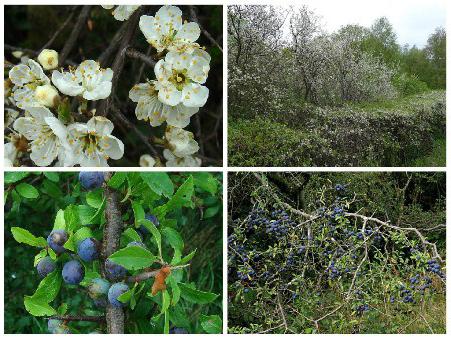

Watering the plum
Both waterlogging and drying out of the soil are approximately equally undesirable processes. That is why it is necessary to moisten the tree only when necessary, while maintaining a stable moisture level.
On average, the intervals between irrigation procedures are 2-3 weeks, and over the summer as a whole, the tree is supplied with 3-6 buckets of water.
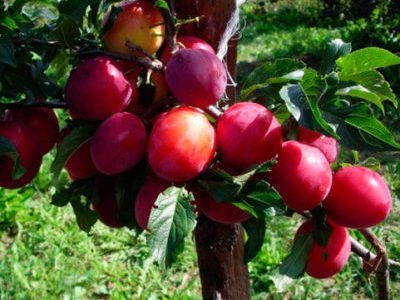

What a plum looks like
Around the end of the 3rd century BC, Theosphates described two types of domestic plum, grown at that time in the Greek territory. One of them was distinguished by especially sweet and juicy fruits.
Scientists believe that the home plum originated in Asia through extreme cross-pollination of wild thorns and cherry plums. From there, the tree was brought to Egypt and Greece, where they began to actively cultivate it.
Plum is a tree or bush
Shrubs do not have a main trunk. Several of their lignified shoots constantly replace each other throughout life: one dies off, and a new one immediately takes its place.
Whereas a tree with the onset of maturity has one main trunk. In addition, the growth of an already formed plant is much higher than that of a bush, whose size is from 0.6 to 6 m. A home plum is a tree with a main trunk and a fifteen meter growth limit.
Plum tree description
Home plum grows up to 15 meters, its height depends on the variety and climatic features of the area. For the same reasons, the crown of a plant is spreading, wide or narrow, extended upward. The root system, located mostly at a depth of 0.45 m, has a rod-like shape.
What are the leaves of the plum
Home plum leaves are arranged alternately on short petioles, up to 10 cm in length, up to 6 cm in width. The edge is serrated, the plate is wider at the base, narrows towards the end and becomes sharp. The reverse side of the leaf is slightly pubescent. The color changes in the fall: from summer green to pale yellow.
How plum blooms + photo
Each flower bud has a simple shape and produces up to 3 white or pinkish buds with a diameter of 1-2.5 cm. Plum flowers are collected in bunches or grow alone.
Their structure is usual:
- 5 sepals of green color;
- 5 petals white or pink;
- 23-30 stamens;
- 1 pistil, superior ovary.
The flowering period occurs in April in the southern regions, in May - in the middle lane, at the beginning of June - in the Urals and Siberia.
Plum tree fruits
The fruit of the home plum tree cannot be classified as a fruit or a berry. Scientists define it as a drupe. Inside the fruit there is one large bone, flattened on both sides, with sharp ends. There is a lot of juicy and sweet pulp around the bone, covered with a thin dense skin with a smooth structure.
Drupes of home plum are varied in shape, taste and color, which depends on the variety. These can be round or oval fruits, colored in red, green, blue or yellow shades.
Homemade plum is rich in useful properties:
- lowers blood pressure;
- has a positive effect on kidney function;
- has a laxative effect;
- able to cleanse the body of cholesterol and toxins.
The drupe contains useful substances:
- potassium, fluorine, sodium;
- proteins;
- alimentary fiber;
- carbohydrates;
- vitamins B, C, B2, E, PP.
For a long time, homemade plums have been used to relieve the symptoms of gout and rheumatism, heart ailments and metabolic disorders.
Where the plum grows
Thanks to selection, home plum can grow and bear fruit in different latitudes and climatic zones. Varieties have been created that are adapted to the most severe conditions.
Historically, the geography of growing domestic plum is determined from the eastern part of the Caucasus Mountains to the Adriatic Sea, which includes the territory of Asia Minor and the Balkan Peninsula.
Plum soil
There is only one requirement for soil, but it is extremely important. The fact is that the plum likes neutral sandy loam or loamy soil and does not like heavy clayey. The first characteristic is decisive, and therefore, with the growth of the tree, the soil is constantly tested for acidity.
In the general case, the normalization of soil acidity is carried out by the introduction of slaked lime once every 4-6 years (for digging, light compositions - 300-400 grams per 1 sq. M., Heavy - 2 times more). For soil prone to acidification, this procedure is performed as soon as the need arises.
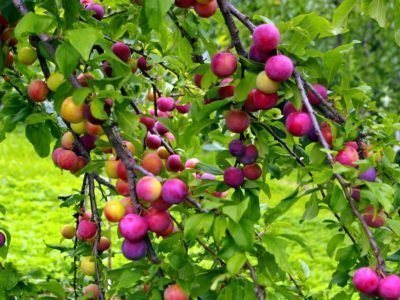

Short description
Home plum is one of the most widespread species in Russia and the world from the Pink family. The species was obtained by natural pollination of blackthorn and cherry plum. The exact picture of the origin of the species has not yet been restored, but it is believed that its homeland may be the territory from the Eastern Caucasus to the eastern coast of the Adriatic. This includes Asia Minor and the Balkan Peninsula. This knowledge will allow scientists, over time, to obtain a drawing of the origin and distribution of the domestic plum.
On the territory of Russia, the first plums appeared in the middle of the 17th century in the garden of the royal family near Moscow, located in the village of Izmailovo. They were brought there from Western Europe. Today they are widespread throughout the world, Europe, Russia, China, and the USA.
What a plum looks like
Plum house is a woody plant up to 15 meters in height with an ovoid crown. The foliage is simple, alternately arranged, with a shortened petiole. Its length is usually 4-10 cm, width varies from 2 to 5 cm. Flower buds are also simple and form 1-3 flowers. Self-fertility varies depending on the characteristics of the particular cultivar, but the presence of other cultivars in the garden always increases the yield of the plum. The plum fruit is a monostyanka with a color from light yellow to deep purple, most often blue. The bone is flattened and pointed at both ends.
Important: a ripe crop must be protected not only from pests, but also from birds.
How long does a plum live
The lifespan of one tree is usually about a quarter of a century. The plant bears fruit for 10-15 years.
Home plum is one of the subdivisions of the genus Plum, which includes more than 250 species. Among them, the most related to the home plum are:
- American plum;
- cherry plum (Russian plum);
- dwarf plum;
- plum moldavian;
- Chinese plum, etc.
Home plum differs from the specified types in color, taste and some other external features. Can vary:
- productivity;
- adaptability;
- winter hardiness;
- resistance to pests and diseases, etc.
note: The difference between the plum species plays an important role in breeding.
Plum is a berry or fruit
It is generally accepted to include plum fruits in the fruit category, but recently it has been suggested that they are berries. In botany, it is generally accepted that berries are fruits with many seeds that ripen on bushes or herbaceous plants. From this point of view, plum fruits growing on tree plantations and having one pit cannot be classified as berries. However, thanks to breeding achievements, it was possible to obtain varieties or to find species that form small fruits on bushy plants. In this regard, the question arose about attributing plums to berries.
Based on botanical definitions, it would be more correct to classify the plum as a fruit. The fruit is a succulent fruit that forms on woody or shrubby plants, resulting from pollination of a flower, having one or more seeds that sprout when dropped into the ground. This definition is closer to plum than berry. Thus, the plum is a fruit.
Plum: tree or shrub
For more accurate selection and cultivation, it is necessary to know the answer to the question: is a plum a tree or a shrub? In culture, there are various varieties of plum, but the house plum in question belongs to trees.
Additional Information: the plant retains this shape even when crossed with woody species.
Plum transplant
Only those plums whose age has not exceeded 4-5 years can be transplanted. In adults, the root system grows so much that digging up a tree can cause irreparable harm to it. Any injuries affect the drain very badly, which must be taken into account when transferring it to a new place, following both the roots and the branches. It is better to “put on” the former in a bag, and the latter to neatly tie up with ropes.
Having taken up the transplant, first of all, you should moisten the young tree well (4-5 buckets of water will be enough) - so it will be easier to dig it up. After that, the tree is buried along a radius of 70 cm from the trunk until a cone-shaped piece of earth with roots is obtained.
With extreme caution, it is pulled out of the ground and transplanted to another site according to the planting rules described a little earlier. Based on the recommendations regarding the planting of plums, the required period for transplanting is the spring wound.
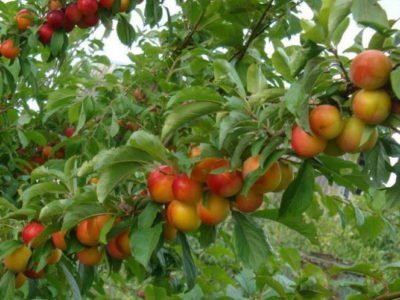

Plum - a berry or a fruit?
Among fruit trees, plums occupy an honorable place, because since ancient times people have been growing them for the sake of harvesting. Sweet dishes, sauces and alcoholic beverages are prepared from the fruits of plum, sloe, cherry plum. Plum is a tree or shrub with a height of 1 to 6 m. All groups of varieties and wild species are high-yielding plants.
The fruit, a single-celled drupe, is formed at the site of the flower after fertilization. Before maturation, the pericarp remains solid for some time, colored green. As the nutrients accumulate, the fruit becomes more juicy, and inside it, in a special nest, a hard bone with a seed is formed.
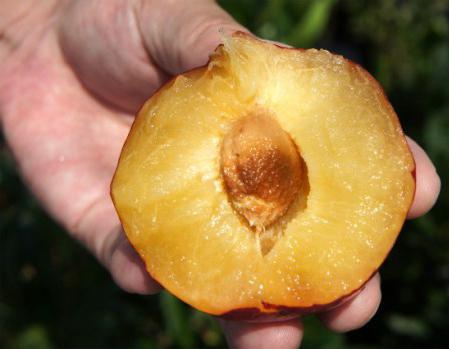

Plum dressing
Fertilize the soil in a specific order. In the first year, fertilizing is not required, for the second, nitrogen-containing ones are introduced 2 times (in the first and last days of June).
But in the 3rd year and in the future (starting from the fertile age) - nitrogen (last days of April), nitrophosphate (June), phosphorus-potassium (August and after harvest).
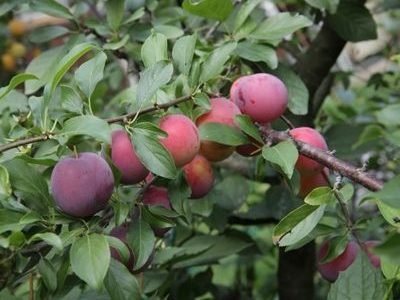

Varieties Skoroplodnaya
Bred in the Moscow region. Recommended for the entire Non-Black Earth Zone.
Trees with a broadly spreading medium thickened crown. They have good winter hardiness and are resistant to fungal diseases. Fruiting in the 2nd year after planting, abundantly and annually.
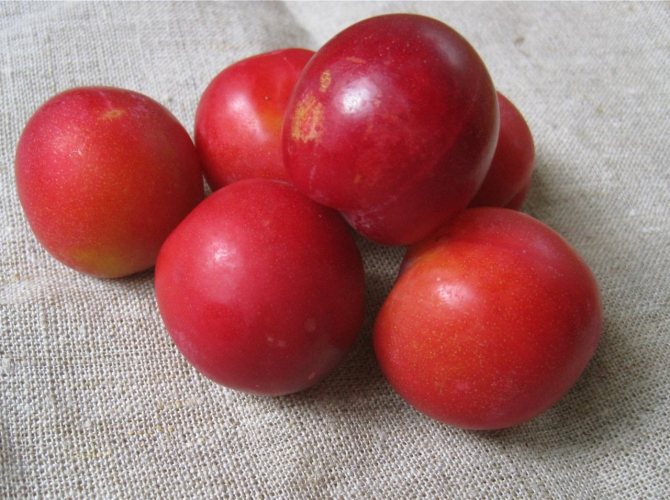

The fruits ripen in the second half of August. They are of medium size (weight 20 g), round, light yellow, bright red in color, with a waxy bloom; the pulp is juicy, sweet and sour, aromatic, with a good refreshing dessert taste. The fruits are used fresh and for the preparation of compotes.
Pruning plums in spring
One of the most important maintenance points is pruning the plum. It begins in the spring with the formation of a crown at a height of the stem of 27-40 cm. The crown is left with 5-7 good branches, which are shortened at first, in order to prevent their incorrect growth.
Following the onset of the fruiting phase, the conductor is cut off above the upper lateral shoots, thereby contributing to a good illumination of the crown.
Sanitary and thinning pruning with complete removal of damaged branches, overgrowth and stems growing towards the trunk and interfering with each other is performed as needed.
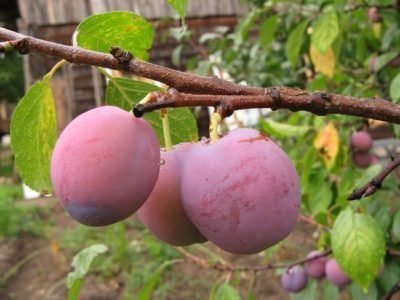

How to properly care for your home plum
Plum is far from the most whimsical fruit tree, planting and caring for it does not require much effort, if you know when and what to do.
Important! With the arrival of spring, you need to hang birdhouses on the trees. This is to attract birds to help fight pests.
In mid-March, you can safely start pruning homemade plums. In April, the soil around the tree trunk must be dug up with nitrogen fertilizers.
For trees that are more than one year old, you need to take 150-200 g of urea or calcium nitrate, and for a plum that has entered fruiting, 350-400 g.
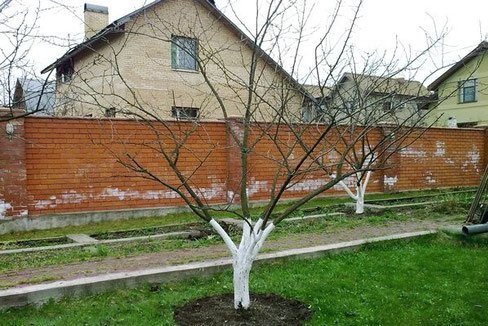

You need to dig the soil around the trunk very carefully, no deeper than 10 cm, so as not to damage the root system. In the spring, it is necessary to carry out preventive work against diseases and pests that may be in the bark of a tree or in the soil around the trunk.
In the summer, after the plums have bloomed, they need mineral and organic fertilizing. The proportions for summer feeding are the same as in spring. In hot, dry weather, the house plum should be watered.
At the end of August, the tree begins to bear fruit, and you can already harvest. To prepare the plum for the winter period, water-charging watering of the tree is carried out. Next, we will consider in detail the conditions for the correct cultivation of plums.
How often to water your home plum
You need to water your home plum so that the depth of the soil is 40 cm moistened. Watering plums during the growing season depends on the amount of precipitation, usually the soil is moistened up to 5 times. Up to 6 buckets of water are poured under young trees at a time, and up to 10 buckets under the spawning plum.
Watering plums in autumn is mandatory, it charges the soil with moisture until spring and at the same time increases the resistance of trees to frost.
Feeding homemade plums
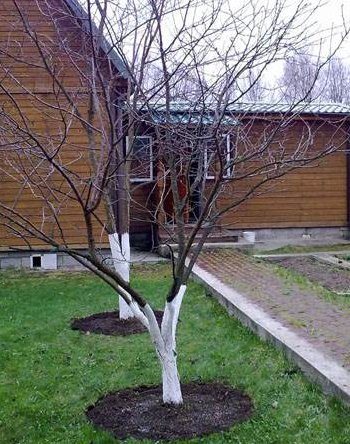

Top dressing of home plums is usually combined with loosening the earth around the tree. It is customary to apply organic fertilizing once every 4 years at the rate of 11-13 kg per m², and mineral fertilizers - once every 3 years.
Potash and phosphorus fertilizers are applied in the fall, and nitrogen fertilizers - in the spring. In the first and fourth years after planting the home plum, together with digging, 70-90 g of ammonium nitrate, 150-180 g of superphosphate and 45-50 g of potassium salt are added.
At the 7-8th year of the tree's life, the feeding rate is doubled.
Features of pruning a fruit tree
Pruning of home plums most often takes place in the spring, when sap flow has not yet begun.
Did you know? Since home plums grow vigorously in the first years of life, pruning is best done in the second year.
The crown of a tree is usually formed over 5 years.In the year when the plum was planted, it should not be cut, but in the second spring up to 7 skeletal branches appear on the tree below, located at the same distance from each other with an angle of 45º from the trunk.
At this time, you can begin to form a tier, while you need to retreat along the trunk from the surface of the site by 50 cm, and the branches that grow lower must be removed. Branches that are above the stem at an angle of 40º are also best removed, otherwise they may break off during the fruiting period. Skeletal branches should be cut by ⅓, and the remaining ones are cut into a ring, without leaving hemp.
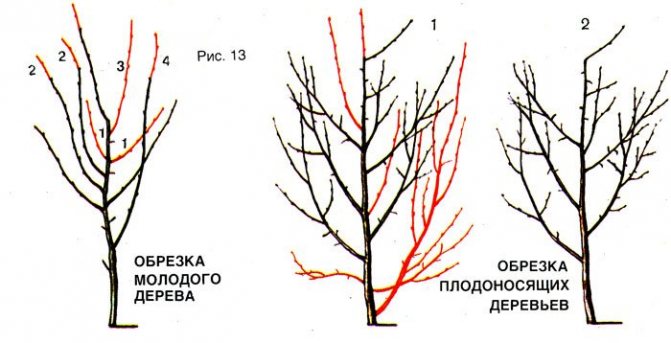

The conductor should be shortened so that the one-year-old tree is up to 1.8 m high. In the third year of the tree's life, the conductor should be shortened 40 cm above the uppermost branch, so that the conductor will grow straight.
Trimming the conductor in the fourth year should be done so that it is about 6 buds longer than the skeletal branches. It is necessary to cut the conductor until its height is 2.5 m. After the formation of the crown, the pruning is used to stimulate the regrowth of new fruit branches, which give the main harvest.
Important! Pruning home plums is carried out with sharp tools, all cuts must be processed with garden pitch.
Prevention of diseases and pests
Home plum after planting requires not only watering and pruning, it also needs protection from pests. Preventive treatment of home plums is carried out in the spring, usually by the end of March, when the sap flow of the plant has not begun. For the solution, add 700 g of urea to 10 liters of water.
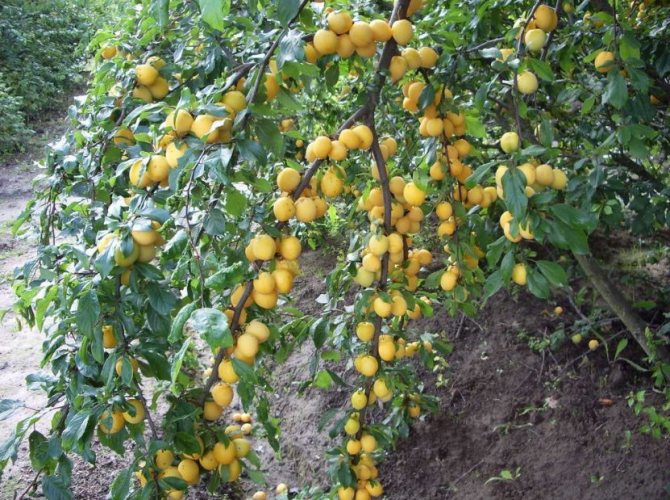

During processing, pathogens and pests that survived the winter period die, but the plant receives nitrogen fertilization. If the buds on the tree have blossomed, and you did not have time to process them with urea, then you need to use drugs such as "Agravertin", "Iskra-bio", "Fitoverm".
After such treatment, the trees are sprayed with a solution of "Zircon" or "Ecoberin", this is necessary so that the resistance of the tree to diseases and temperature changes increases.
Plum grafting
Plums can be propagated using seeds, shoots, green or root cuttings and grafting. Of all the vegetative methods, which, by the way, are much more reliable than seed, the most popular today is green cuttings, which stand out for the high survival rate of young animals. But not all varieties of plum are able to root in this way (varieties with abundant formation of root growth are well cuttings), which, in particular, applies to the plum plum - it is propagated either by grafting or by budding.
As a rootstock, a root shoot of the same early-ripening red, planted next to it for pollination, is suitable. Inoculation into the split is performed step by step by cutting the stem of the stock, making a split in the central part of the cut to a depth of 3 cm, cutting the cutting from the bottom from both sides to the shape of a wedge, inserting it into the inside of the split and wrapping the grafting area with polyethylene material.
To make budding in the butt (applicable in dry weather, when the bark is difficult to bend), a 7-centimeter (in length) incision is made on the rootstock bark, capturing a thin layer of wood. The stalk is sharpened so that its lower part with an oblique cut of the same length immediately under the bud contains a ledge inserted into the stock under the bark with wood to wood.
Again, after the grafting work has been carried out, the junction should be tied using the same polyethylene and leaving the bud of the scion free. When 3 weeks have passed, the film should be removed. The top of the stock at the beginning of spring must be cut off so that about 15 cm (in length) thorn remains above the bud.
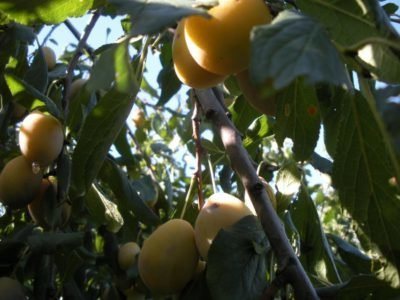

Variety Memory Timiryazev
The variety is obtained from crossing the varieties Victoria and Skorospelka red.
Propagated by shoots and grafting (the best graft is for seedlings of the Skorospelka red variety). The trees are vigorous, with a rounded spreading crown. Timber and fruit buds of medium winter hardiness.In terms of endurance, the variety is almost as good as Early ripening red.
It begins fruiting early - in the 3-4th year.


Fruiting on bunch of twigs and annual growth. Fruit ripening is amicable, in the first half of September, almost without shedding. In cold years, the fruits ripen with a great delay.
Plums are egg-shaped, yellowish, with a beautiful red blush, their weight is 20–25 g. The pulp is yellow, medium density, juicy, aromatic, sweet, with a little acid, pleasant to the taste. The stone is medium in size, it separates well from the pulp. The fruits are suitable both for fresh consumption and for processing into jam and compotes. The variety is zoned in Moscow, Ryazan, Tula and other regions.
You should choose a seedling with a stem thickness of at least 2–2.5 cm.
Plum propagation by green cuttings
Returning to the topic of green cuttings, it should be clarified that the procedure should be carried out in June, with the active growth of shoots. The length of the cutting should be 30-40 cm, it is desirable that it be cut from a young plant in cloudy weather.
Having placed the stalk in water, using a well-sharpened tool, it is leveled from below with the accompanying removal of the lower leaf to half of the petiole. In this case, the location of the upper cut is set immediately behind the 3rd sheet. Next, a bunch of cuttings for the night period are lowered with their lower ends into a solution of heteroauxin to a depth of 1.5 cm.
The entire rooting process should take place in a mini-greenhouse, the arrangement of which should be taken care of in advance. Preparation of the substrate for germination consists in mixing peat and sand in equal proportions, sprinkling the mixture with a layer of sand to a thickness of 1 cm, watering and light compaction.
It is necessary to plant cuttings, observing an angle of 45, a depth equal to the length from the bottom of the cutting to the petiole remaining from the 1st leaf, a mutual distance of 5-7 cm and an inter-row 5-cm gap. After that, a transparent cover is made for them and moved to an illuminated place protected from direct sunlight.
Watering is carried out using a divider, top dressing - after 30 days from the moment of planting, using a solution of nitrogen fertilizer (30 grams per 10 liters of water). After rooting, you need to remove the cover.
Further care comes down to preserving the cuttings until spring, which involves digging them up in the last September days, covering the roots with moistened moss, wrapping them with foil and storing them somewhere in a shed. With the arrival of spring, they are again planted in the soil. Growing before planting on the site lasts 2 years.
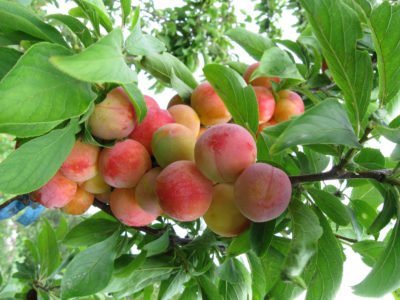

Plum
Home plum (Latin Prunus domestica) - fruit plant; species of the genus Plum of the subfamily Plum of the Rose family.
Botanical description
A tree 6–12 m high (up to 15 m) with a wide or narrow ovate crown. The trunk is 30-60 cm thick in diameter. The life span of a tree depends on the variety and can reach 25 years, the productive period is 10-15 years. Early-fruiting varieties begin to bear fruit in the second - third year after planting, late-fruited - in the sixth - seventh year. The root system is pivotal; most of the roots are located at a depth of 20–40 cm.
Leaves are alternate, simple, short-petiolate, elliptical or obovate, with a crenate or serrate edge, pubescent underneath; length 4-10 cm, width 2-5 cm.
The flower buds are simple, give 1–3 flowers. The flowers are white, with a diameter of 1.5–2 cm. The self-fertility of the plum depends on the variety, but the yield always increases when there are different varieties in the plantings.
The fruit is a monostyanka, purple, yellow, pale green, red, black-blue, with a gray waxy bloom. The bone is flattened, pointed at both ends. Karyotype: 2n = 48.
Origin
When the blackthorn (Prunus spinosa) (2n = 32) was crossed with the cherry plum (Prunus divaricata) (2n = 16), a plant was obtained that was completely identical to the domestic plum. This plant, like the domestic plum, had 2n = 48 chromosomes. Probably, the wild plum evolved this way.
The southern cherry plum has a yellow-red color, the northern turn is dark blue. Their descendant combines the features of both types: cold hardiness of blackthorn and the taste of cherry plum, has a color in a wide range of blue-yellow-red shades (in different varieties).
The geographical center of origin can be considered a territory stretching from the Eastern Caucasus to the eastern coast of the Adriatic Sea, including the Balkan Peninsula and Asia Minor.
- Prunus domestica subsp. domestica
- Prunus domestica subsp. institia - Ternoslum
- Prunus domestica subsp. intermedia
- Prunus domestica subsp. italica (including rotunda) - Greengage
- Prunus domestica subsp. oeconomica
- Prunus domestica subsp. pomariorum
- Prunus domestica subsp. prisca
- Prunus domestica subsp. syriaca - Mirabel
Hybrids
For a long time, work has been carried out abroad on crossing plums with apricots. The hybrid between them is called breeding cat
, and a hybrid from re-crossing (that is, a hybrid of a breeding cat and a plum) -
pluot
(plum - "plum", apricot - "apricot"). The plucks have already entered commercial breeding. Since they are all created on the basis of Japanese non-resistant plums, foreign plums do not feel very well even in the Krasnodar Territory.
In Russia, they crossed the Russian plum (hybrid cherry plum) with an apricot and gave the hybrid the name plumkot (a hybrid of a real cherry plum with an apricot is called a black apricot). Plumcotes are quite winter-hardy, productive, their bone is semi-detachable, fruits weighing about 20 g (at the level of the Kuban Comet). Two new plumecots have now been obtained. Hummingbird (Mouse) - very winter-hardy, dwarf (the tree does not grow above 3 m), well cuttings, high quality fruits. Plumkot Kuban is a seedling from free pollination of the Kuban Comet with a black apricot, its winter hardiness is high, the tree is weak, early ripening (earlier than Hummingbird), perfectly cuttings. Apparently, both varieties of winter hardiness can be suitable for the middle lane. The tests of these plumecots have not yet been completed.
Economic value and application
Homemade plum fruits contain vitamins A (in dark fruits), B1, B2, C and P and essential elements: potassium, phosphorus (the content of which is higher than in apples and pears), calcium, magnesium, iron. The sugar content (depending on the variety and growing conditions) ranges from 9 to 17% (fructose, glucose and sucrose). Plum fruits also contain organic acids (malic and citric, as well as oxalic and traces of salicylic), pectin, tannins, nitrogenous substances.
Dried plums are called prunes and are classified as dried fruits.
Late spring honey plant, during flowering gives honey bees up to 10 kg of honey per hectare of plantations.
Non-drying oil for the medical industry is obtained from the seeds of the home plum. The pulp of the fruit is part of the drug "Kafiol".
Plum trees are valued as ornamental and are used for landscaping. Notable in color.
Color / appearance: The core of a plum can have a variety of colors, usually yellowish brown, with stripes of pink, orange, red, purple, olive or gray. Due to the small size of plum trees, curly or irregular textures are common, as well as knots and other defects.
Plum wood is used to make: turned products, musical instruments, inlay and knife handles.
Mechanical properties and characteristics of wood (dry wood - moisture 12%)
| Rod - | Prunus |
| View - | domestica |
| Other names - | Plum |
| Density - | 795 kg / m³ |
| Solid. Yanka - | 6.9 kN |
| Static bending strength - | 88.4 MPa |
| Modulus of elasticity in static bending - | 10.19 GPa |
| Spread - | Cultivated in temperate regions around the world |
Related wood species
Types of wood with similar properties (density and hardness coincide in value ± 10%)
- Afromosia (Pericopsis elata)
- Density - 730 kg / m³
- Solid. Yanka - 6.98 kN
- Hornbeam (Carpinus betulus)
- Density - 735 kg / m³
- Solid. Yanka - 7.26 kN
- Turbidity (Guibourtia arnoldiana)
- Density - 850 kg / m³
- Solid. Yanka - 7.34 kN
- Ormosia (Pericopsis mooniana (Ormosia monosperma *))
- Density - 770 kg / m³
- Solid. Yanka - 6.49 kN
- Panga-panga (Millettia stuhlmannii)
- Density - 870 kg / m³
- Solid. Yanka - 7.31 kN
- Peroba (Aspidosperma polyneuron (syn. A.dugandii, A. peroba))
- Density - 755 kg / m³
- Solid. Yanka - 7.45 kN
Diseases and pests
The good health of the plum, especially the yacht plum, relieves it of many diseases of fruit trees. However, careless care and some varietal exceptions still weaken its defense mechanisms against certain external influences.
For instance, gum flow - one of the most common diseases among plum trees, but specifically, the yacht plum practically does not suffer from it. Its causes are deficiencies in maintenance, such as mechanical damage to the trunk due to careless work with the tool, overdoing it in pruning, as well as natural factors such as cracking of the bark after temperature extremes.
If this disease is started, the plum can die. To get rid of the disease, each growth of solid resin found on the tree must be cleaned off with a knife before the unaffected wood is opened and the wound areas should be disinfected with copper sulfate (1%), then they should be repaired with garden varnish.
On the other hand, plum aphid poses a serious danger to both other drains and the yacht. These pests, densely dotting the foliage, suck the juices from the tree, which is fraught with drying and falling of leaves.
Having identified the parasites, it is necessary to take measures consisting in insecticidal treatment (1 tablet of Intavir per 1 liter of water) and the autumn cleaning of the trunks from the old bark along with the insects hibernating in it. As a preventive measure, in this case, it is recommended to whitewash boles and skeletal branches, as well as the timely destruction of overgrowth (of course, in varieties that actively form it).
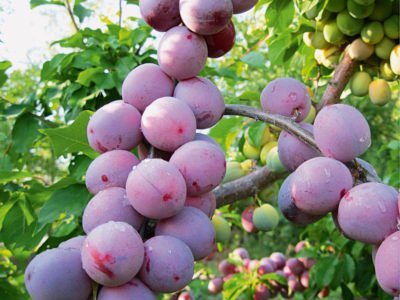

Useful qualities of plums
People use the fruits of wild and cultivated plants for food, for processing into juices, preserves, jams, liqueurs, as a filling for baking, as a medicinal raw material. Home plum has long been grown for the sake of juicy drupes with a bluish bloom. Homemade plum fruits contain:
- carbohydrates (fructose, glucose);
- vitamins C, A, P, group B;
- organic acids;
- tannins;
- trace elements;
- pectins.
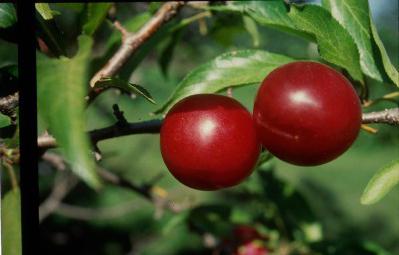

Traditionally, in the 20th century, two groups of varieties were distinguished in the composition of the species - Hungarian and Renklody. The former are represented by trees and shrubs with blue-violet round or elongated fruits. Renklods often have spherical greenish fruits. Now the main direction is the breeding of low-growing subspecies, interspecific crossing and obtaining hybrids, for example, plums and apricots.
Pickled plums cooking recipe
There are plenty of culinary recipes with plums. These include classic desserts, pastries and drinks. This fruit is thermally well processed and goes well with meat.
You can start cooking delicious dishes with pickled plums, for which we take:
- 6.5 kg plums,
- 1 bag of cloves
- 1 bag of cinnamon
- 2.5 liters of water
- 1 kg of sugar
- half a liter of 9 percent vinegar.
Wash the fruits, remove their stalks, blanch in 80-degree water for 2-3 minutes and cool quickly under running water.
Put cloves with cinnamon on the bottoms of the cans and spread the fruit thickly on them, then pour the hot marinade filling there, close the lids and posterilize at a temperature of 90 ℃ (half-liter cans - 12-15 minutes, liter - 17-20, 3-liter - 30-35).
Roll up, turn the bottoms up and leave to cool in the air. These plums are just great with meat. The total mass of ingredients and marinade should be enough for 10 liter jars.
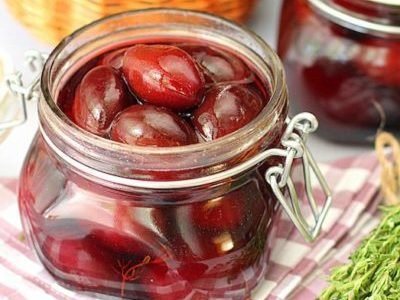

Plum variety Iskra
Trees are medium-sized, young - with a wide-pyramidal crown, and older ones - with a rounded one. Propagated by root shoots and budding. The best rootstocks are seedlings of local varieties of plums.
Fruits weighing 15-17 g, rounded ovoid, dark red, with a slight waxy bloom (less colored in cold years). The pulp is light yellow, juicy, sour-sweet. The stone is small, well separated from the pulp.The fruits are suitable for fresh consumption and for processing into jam and compotes.
A characteristic feature of the Iskra variety is early maturity, annual and high yield. 2-year-old trees begin to bear fruit already in the nursery, 2-3 years after planting. In subsequent years, yields increase (4–8 kg of fruits are harvested from 4-year-old trees, 12–15 kg from 5-year-old trees, 16–20 kg from 6-, 7-year-old trees).
The variety is zoned in the Moscow, Ryazan and Smolensk regions.
Plum jam recipe "Gumbo"
Making a plum jam called “Gumbo” is relatively easy. For this you need:
- 2 kg plums,
- finely chopped thin peel of 2 oranges,
- finely chopped thin peel of 1 lemon,
- 1.5 kg of sugar
- 250 grams of finely chopped pitted raisins,
- 125 grams of finely chopped walnuts without shell.
Put both peels, plums, sugar, raisins in a large saucepan and squeeze the lemon and orange juices on top. Boil the mixed ingredients over low heat for about half an hour until everything thickens and the plums soften.
Then add the nuts, stir the boiling mixture for another 10 minutes (slow fire), and its density will become more pronounced. Ready jam can be poured into warm sterilized jars and sealed.
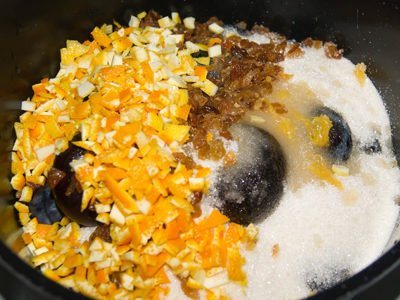

Fruit and berry plants
Homemade plum
Plum is a tree of the Rosaceae family up to 8-12 m high, with fruits that are different in shape, color, size, taste and aroma (depending on the variety).
Currently, there are about 2000 varieties of plum in the world, which is one of the most important fruit crops in countries with a temperate climate.
However, its best varieties are common in more southern regions.
Home plum is the result of natural crossing of blackthorn and cherry plum.
It first appeared in the Caucasus, from where it came to Central Asia and the Mediterranean in ancient times.
From the North Caucasus, the plum reached the southern and other regions of Russia.
In addition, in 1664, domestic plum trees were brought from abroad through Arkhangelsk for the Tsar's Izmailovsky Garden.
Currently, in Russia, different varieties are bred almost everywhere, with the exception of only the northern regions.
The nutritional value of plums is determined by their chemical composition, and the content of various substances in the fruits depends on the variety and growing conditions. The sweetest variety is renklod.
Plums contain from 9.4 to 16.28% sugar, consisting of fructose, glucose and sucrose, pectin (up to 2%), organic acids, nitrogenous and coloring substances, mineral salts (potassium, etc.), carotene, vitamin C and some vitamin B1.
Plums are consumed fresh and processed. They are used to make compotes, preserves, jam, liqueurs, confectionery. The taste and nutritional qualities of canned and frozen fruits are well preserved.
Plum is useful for everyone and especially for those who suffer from intestinal lethargy.
The most popular are dried black plums - the so-called prunes, whose fiber and sugary substances enhance intestinal motility.
Hungarian is considered the best variety for making prunes.
It is cultivated mainly on the Black Sea coast of the Caucasus.
Infusions and compotes from prunes have established themselves as an excellent mild laxative.
10-20 pcs. Also have a laxative effect. prunes eaten before bed.
There is evidence that prunes promote the elimination of cholesterol from the body and can be recommended for atherosclerosis and gallbladder diseases.
Prunes are useful for hypertension and kidney diseases, since the potassium salts in it contribute to the elimination of water and table salt from the body.
One of its advantages is the high calorie content, which is 4-6 times higher than the calorie content of fresh plums. But because of this, prunes are not recommended for obesity and diabetes mellitus.
For storage and use all year round, plums can be dried on their own. To do this, fresh fruits washed with clean water are immersed in boiling water for 1-1.5 minutes, then cooled in water and laid out in one layer on a wire rack, sieves, etc., which are placed in an oven or special dryers.
First, they are dried for 3-4 hours at a temperature of about 50 ° C, and after cooling - again at a temperature of 65-70 ° C.
In well-dried plums, the juice is not squeezed out when squeezed and the seeds do not move freely.
Dried plums are stored in sealed jars or bags in a dry, dark room.
Plum juice is also a dietary product, especially with pulp. Almost all the valuable nutrients of fresh fruits are preserved in it.
Such juice improves appetite and digestion and serves as a supplier of vitamins for the body in winter (with low acidity of gastric juice, it is recommended to use only sour varieties of plums).
Plum is widely used in folk medicine for the treatment of various diseases: gastrointestinal and renal, rheumatism, gout.
Decoction of plum leaves in vinegar is used to lubricate old and festering brines, achieving faster healing.
As a wound healing agent in folk medicine, fresh or steamed dry plum leaves are sometimes applied to wounds and ulcers.
Plum is a garden berry, actively used in cooking as an independent delicacy, and as a component of many types of desserts and pastries, and it is also excellent for preservation. Containing many vitamins and microelements, plum is known for its biologically active action. Today you can find a wide variety of plum varieties. And for you we will present their photo with a title and description.
The most popular varieties of plums for Russia
If you are looking to plant plums in your backyard, then you should look at the varieties that are best suited to your region. Of course, there are a lot of varieties and for you we presented the best varieties of plums, as well as their photos.
Top hit.
This variety has a late ripening. The fruits are large, egg-shaped, weighing about 80 grams. It ripens in September and has a tasty pulp with a slightly sour taste.
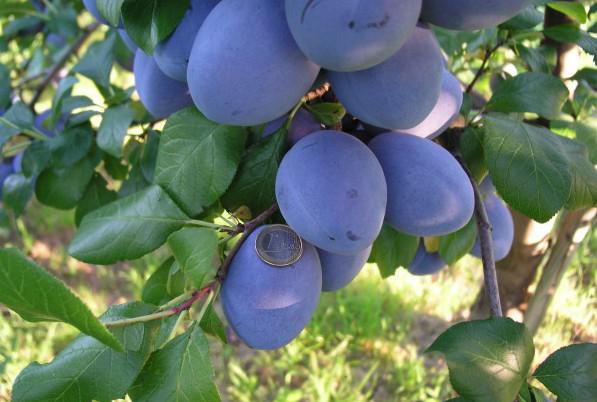

The president.
Differs in high yields. Unpretentious and partially self-pollinated variety. The berries weigh 70 grams, they are very juicy and tasty. Suitable for fresh consumption.
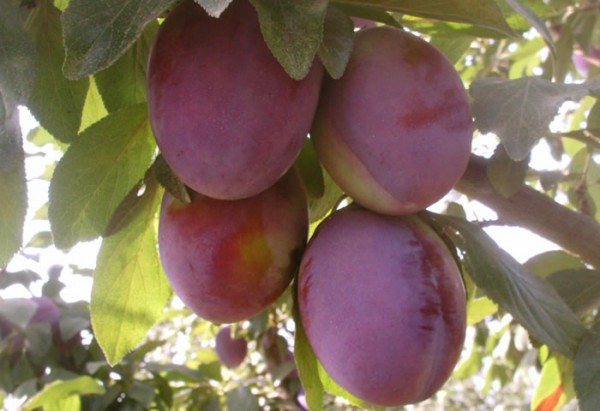

General's.
Suitable for canning, has a delicate and mild taste. Trees grow short and hardy. Bloom in late May and bloom for about 3 weeks.
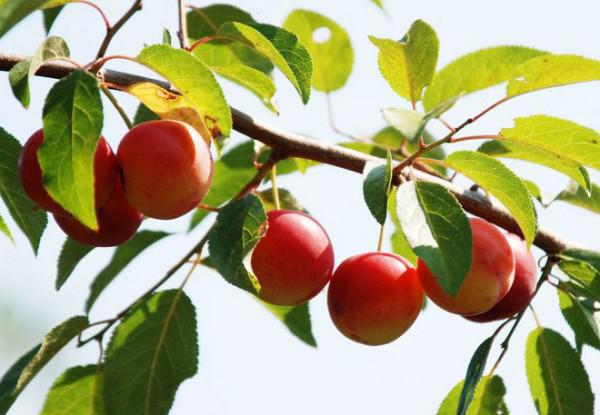

Morning.
Oval fruits weighing 26 grams. The skin is colored green with a yellowish tinge. The pulp is yellow and juicy, with a slight sourness on the palate.
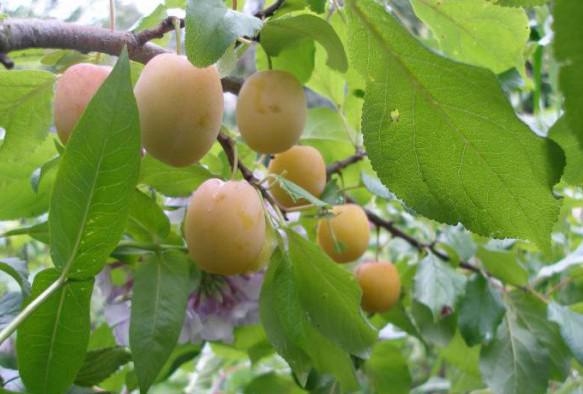

Nenka.
You are most likely wondering what varieties of plums exist. And just here you will see the information you are looking for. A tree of this variety of medium height with a wide pyramidal crown, brings a rich harvest. Its berry weighs 20 - 22 grams, round in shape. Frost-resistant, fruits contain many vitamins and microelements.
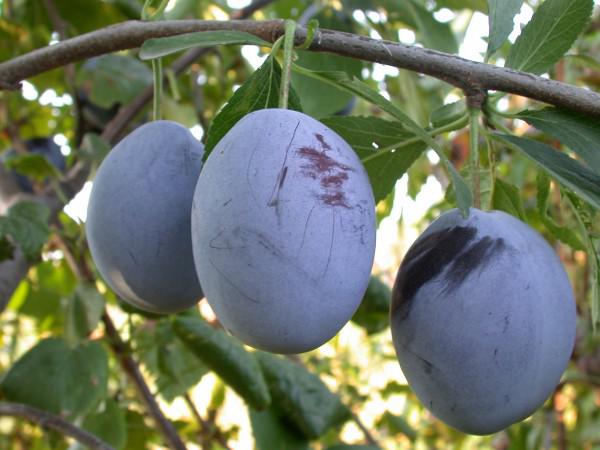

Alyonushka.
Bred in China. Has a spherical crown. The fruits are large in size and have a bone inseparable from the pulp. The leaves are very similar to peach leaves.
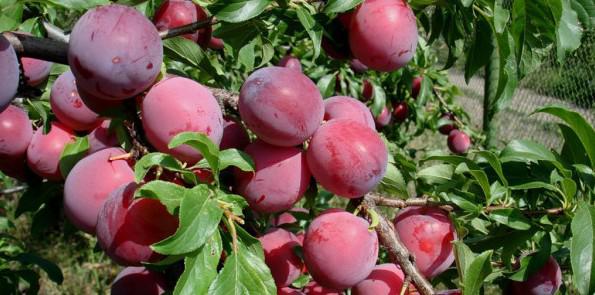

Romain (red plum).
The red color is inherent not only in the fruit, but also in the leaves. Heart-shaped berries with an almond flavor.
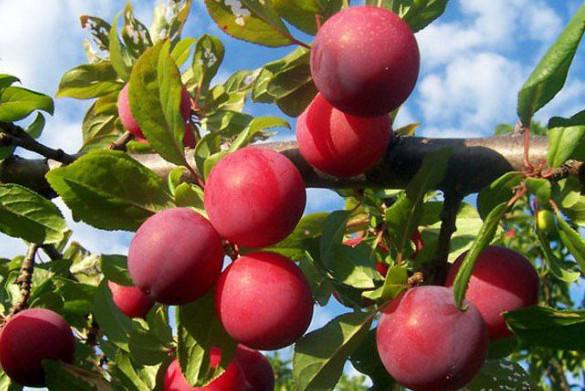

Chemal large.
Begins to bear fruit as early as 3-4 years after planting. Differs in frost resistance. Loves moisture and is not self-pollinating.
Spiked Blue Sweet.
In terms of ripening - mid-season. The compact crown gives abundant yields. Fruits are sweet and juicy with a weight of 45 - 60 grams.
Egg.
The name characterizes the shape of the fruit. The color is purple, suitable both for fresh consumption and for blanks. Unpretentious and frost-resistant.
Honey white.
Excellent taste, similar to May honey. The tree grows up to 5 meters. Early flowering and high yield.Not self-pollinated.
Red ball.
We continue to present you with a description of the plum variety. The next variety grows up to 2.5 meters in height. Crohn of medium density. Fruits are large, weighing 44 grams, round in shape with a red skin. And the pulp is light yellow, juicy and loose. It perfectly tolerates transportation, it is recommended to use it fresh.
Eurasia 21.
Trees grow tall with a chaotic crown. Round berries reach 33 grams of mass. The skin is red - burgundy with a waxy coating. The taste is juicy, with a slight sourness.
Tula black (Bryansk late).
A productive and self-fertile variety. Ripening is late. Excellent winter hardiness. The fruits are oval, medium in size. Dark blue color, but reddish flesh.
Blue gift.
Mid-season variety. High-yielding and partially self-pollinated. The fruits are purple-blue, large and tasty.
Early ripening red
The result of folk selection. Precocious and self-fertile. The fruits are oval with a purple color. The pulp is firm and red, slightly sour. Matures in August.
Oh yeah.
Here you can see varieties of plums that are suitable for central Russia. But back to the description of plum varieties. An early ripe variety on a low tree. Unpretentious, grows even on loam and gives a rich harvest. You just need to moisten the soil and apply organic fertilizers. The fruit is purple, fleshy, sweet and sour.
Kuban legend.
Medium-high variety with a wide crown. Egg-shaped berries reach 30 - 35 grams. The skin is red-violet with green flesh.
Vicana.
A suitable option for growing in the North - West of our country. Low height, with a thin falling crown. Fruits are oval in shape, weighing 24 grams and burgundy in color. The bone is easily detachable. Suitable for both fresh consumption and canning.
Valor.
A medium-tall tree is considered Canadian. Egg-shaped blue fruits with a clearly visible seam weigh 50 grams. Light blotches can be seen on the surface of the skin. The pulp is greenish-creamy and very juicy.
Memory of Timiryazev.
Medium-high variety with a weeping crown. The berries are elongated - oval in shape, with a juicy yellowish pulp and weighing 23 grams. It is easy to separate the bone from the pulp.
Hungarian.
The fruits are red in color, ovoid or oval in shape. The stone is easily separated and the berries are used to obtain prunes. It has firm flesh with a sweet taste and sugary consistency. Ideal for storage and transport.
Greengage.
It has a firm, juicy and sweet flesh. The stone is easily separated, the berries are stored for a long time, but they do not tolerate transportation. It is better to pick them up when they are still unripe and either eat them right away or process them.
Mirabel.
Early plum varieties cannot be imagined without this variety. It has a juicy and sweet pulp with an excellent separating bone. The fruits are oval and small, pointed at both ends. Something similar to cherry plum.
Teroslum.
Small trees with dark blue fruits. A prolific, hardy and unpretentious variety. Perfect for conservation.
Damascene.
It has fruits of both oval and round shapes, and they can be red, black, blue, and even white in color.
Canadian plum.
A very early variety with frost-resistant buds. But several trees are needed for cross-pollination.
Burbank.
Diploid variety with large, tasty berries. The full name is Burbank Giant. Resistant to frost and monoliosis.
Kabardinka.
Ripens by mid-August. The shape of the fruit is spherical, weighing 30 - 45 grams and tasty pulp.
Angelina.
A variety similar to cherry plum. Possesses a wide-pyramidal crown. If you cut the crown in the first years after planting, this will help speed up fruiting, about 3 years after planting.
Masha.
Medium-tall tree with a berry weight of 30 - 35 grams. The skin is brown and the flesh is light yellow.They ripen by mid-July and have an excellent taste. The bone is easily detached.
Finally
If you like plums, it can be difficult to determine which variety is better. And this is all because there are so many varieties of this fruit. You can get lost in their quantity. Be aware that in any case, with the right care for any of the varieties, you can get an excellent harvest that delights in taste and benefits both children and adults, strengthens the immune system and promotes healthy digestion. Plum compotes opened on the New Year's table will remind you of pleasant summer days on a frosty night, filling the room with a fragrant garden aroma. And pies with plum jam will delight both guests and hosts at any family celebration!
Homemade plum wine
Plum wine, like grape wine, is very different depending on the color, in this case, fruit. So from blue and purple plums, you can get a thick ruby-red wine, and white and yellow (like a ychontovaya plum) are suitable for light, almost white.
In any case, you need to stock up on ripe or even slightly overripe fruits, of course, they should be fresh, not spoiled and not moldy. In this case, it is better to let them “lie” in the sun for 2 days. Homemade fruits do not need to be washed, because they will ferment even more intensively, but store fruits should be washed.
So, to prepare fortified homemade plum wine, we take the pitted fruits for a total weight of 6 kg, cut and tamp it slightly, pour 2-3 liters of vodka with top, insist for 3 weeks, then merge into another vessel.
Add highly heated water to the remaining pulp a little above its level, let it cool, filter and squeeze. Mix the resulting liquid with sugar in equal proportions. Combine the syrup with vodka tincture, close it with a water seal and leave the wine in this state until it is finished fermenting.
Renkold Altana variety
Originator - J. Prochazka (Czech Republic). He bred this excellent plum from the big green Renclaude seed.
The fruit is beautiful, perfectly colored, large, sometimes large, spherical, somewhat dull at both poles; in length it intersects with a wide, but not deep groove. The skin is thin but firm and peels off easily; it is greenish or light yellow in color, but for the most part washed with a brownish-red blush, painted with the same veins and dotted with yellow dots.
Ripening is not amicable, starting from the end of August and almost until the middle of September.
The tree forms a dense and high crown, enters the fruiting season early, gives birth regularly and very gratefully. the tree loves a warm location and sufficiently fresh soil; needs periodic cleaning of the rapidly thickening crown.
Renklod Altana is a high-quality large-fruited (average fruit weight 40-60 g) dessert variety with an average ripening period. Differs in drought resistance and does not poorly tolerate soil salinity. Its wood is very fragile and fragile.
At the time of fruiting begins 4-5 years after planting. Yields are growing rapidly and is considered one of the highest-yielding varieties with dessert quality fruits. 7-8-year-old trees already yield 30-40 kg of fruit.
The variety is self-fertile. The best pollinators are Green Renklod, Common Hungarian, Anna Shpet.
It begins to bear fruit in the 5-6th year, but the yields are irregular. The yield from 15-20-year-old trees is up to 50 kg. Ripening is mostly simultaneous in late July - early August. Fruit crumbling is insignificant
The fruits are very beautiful, rounded, slightly flattened, reddish or brown, with small white dots, covered with a light blue waxy bloom, reaching a mass of 46 g. The peel is thick. The pulp is firm, yellow, of good taste, aromatic. The stone is rounded-oval, separated from the pulp. The fruits are suitable both for fresh consumption and for processing.
Mid-season varieties
Plum varieties of this group ripen mainly in August, more often in the second half of it. The difference will be not only the ripening period, but also the size of the fruits. Mid-ripening fruits are larger, while the taste is not inferior to July fruits, and sometimes even superior. It is for this reason that plums of this group are used to make wonderful, aromatic and tasty wine. Below is a description of the brightest representatives of mid-season varieties - according to experienced gardeners and breeders.
Immune
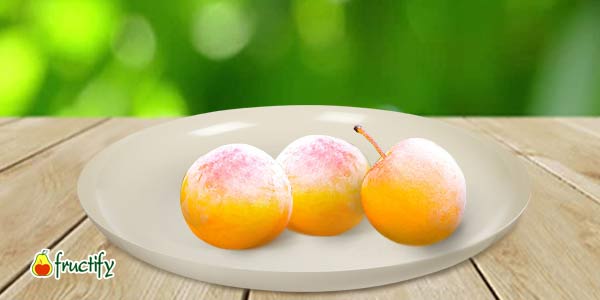

The tree is medium-sized with spreading branches forming a thin fan-shaped crown. Excellent winter hardiness, high yield. The variety was bred in Altai by crossing "Shiro" of American origin with the Ussuri plum. The breeding was carried out by V.S.Putovoy, candidate of agricultural sciences.
The plum ripens at the end of August. The fruits are not large, the average weight is 12 g, they have a yellow color, the shape is spherical, the abdominal suture is clearly visible. There is a pink barrel on the sunny side. The skin is thin, not bitter. The pulp is juicy, sweet, dense and also yellow in color. Breeders and gardeners appreciated the fruits of Imunnaya. The variety is suitable for sale, eaten raw or processed. They make wonderful jams.
Kazan
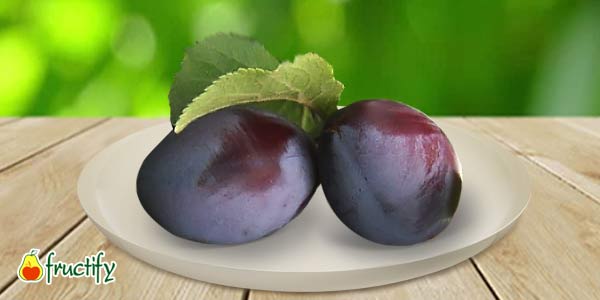

The plant is medium-sized, thickened bush, ovoid. Leaves are broadly oval, dark green. Branches are brown with a raspberry tinge. The tree cannot self-pollinate; this requires "helpers" - Tatar yellow, Early ripening red, Superearly. The first crop can be harvested as early as 3 years. Winter-hardy and heat-resistant - even flower buds can easily tolerate low temperatures in the off-season. Plum yield is good, about 20 kg per plant.
Plums are ready to eat after August 15th. The fruit is large, the usual weight is 30 g, round in shape, slightly compressed at the base and stalk. The ventral joint is not very noticeable. The color is dark, red-beetroot, prune bloom is not intense, go down with a light haze. The skin is thin, the flesh is light yellow, moderately juicy, medium fiber, moderate sweetness. The use of fruits is universal.
Souvenir of the East
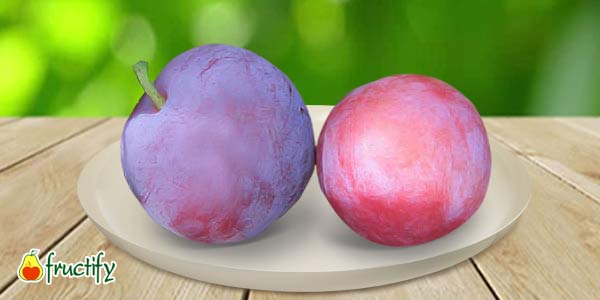

The plant is of medium height - 3-3.5 meters. The bush is sparse, the branches are spreading, the shape is spherical. Leaves are standard size, oblong-oval, matte green color. During the flowering period, in early spring, the plum is covered with small, beautiful flowers. The pollen is sterile, which means a pollinator is needed, any variety of Chinese plum will do. The souvenir of the East easily tolerates low temperatures, frost is not terrible for him, and even flower buds in spring. The variety gives a good harvest, the average harvest per season is 30 kg.
Sugar plum red
The variety was entered in the state register of the Russian Federation in 2009. It was bred by breeders in the Altai Territory, can be grown in film shelters and greenhouses, as well as in open soil.
Belongs to determinant medium early varieties, tomatoes fully ripen in 107-110 days. One brush can contain from 5 to 7 tomatoes. This variety of varieties is subject to storage and tolerates transportation well, and tomatoes are also resistant to cracking. Up to 3.5 kg of tomatoes can be harvested from 1 m2.
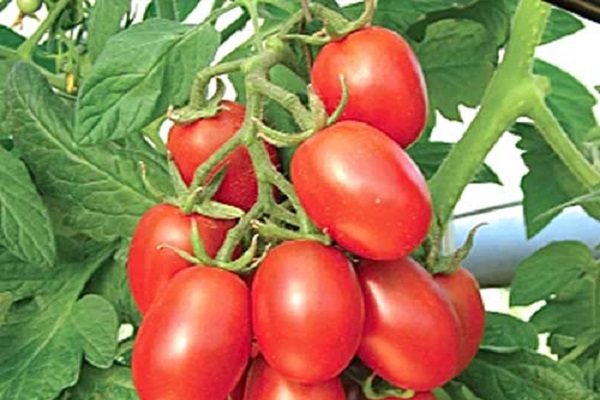

The ripe fruit is red, its weight can be from 20 to 25 grams. It has a shape resembling a plum, the skin is dense, the flesh tastes sweet. Tomatoes of this variety have a high concentration of sugar and various vitamins. Suitable for conservation, subject to heat treatment.
Sugar plum raspberry
For some reason, the variety has not yet been entered in the register of the Russian Federation. It was created by domestic breeders. Recommended for greenhouse planting, but can also be grown in open soil. The plant is semi-determinate, the bushes grow up to 1.4 meters. One square meter can accommodate from 7 to 9 bushes, which yield up to 9 kg.
Yielding, versatile and transportable."Sugar plum raspberry" is ranked among the early ripening varieties, the first fruits can be tasted 87-95 days after the sprouts appear on the soil surface.
The fruits are red-crimson, elongated, reminiscent of a plum. Their weight is generally 20-25 grams. The pulp is fleshy, there are few seeds in it, the fruit is equipped with two chambers. Fruits have a lot of useful vitamins and sugars.
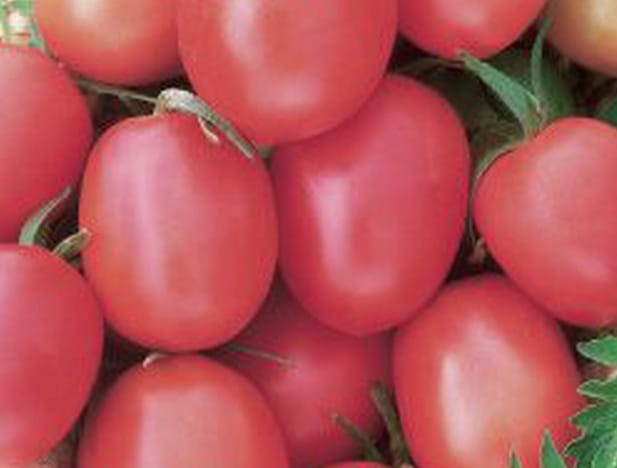

Sugar plum yellow
Listed in the state register of the Russian Federation in 2008, suitable for planting in greenhouses and open soil. Belongs to early varieties, the fruits ripen 88-95 days after germination. The bush is semi-determinate, medium-tall can grow up to 120-140 centimeters. It is considered fruitful, from 1 square meter you can harvest up to 9 kg of delicious tomatoes.
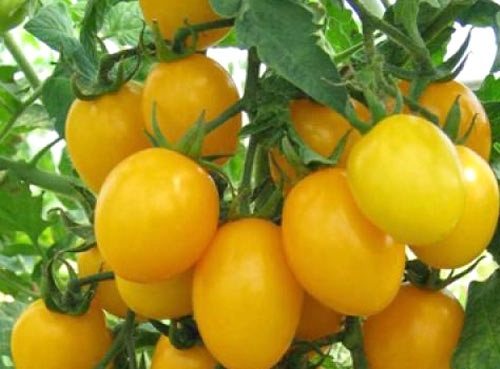

Fruits are small, up to 25 grams, elongated, rounded; at the stage of ripening, they turn yellow. Tomatoes are rich in carotene, the flesh is sweet in taste, the fleshy has two chambers, the skin is dense and does not crack. The bushes are resistant to tobacco mosaic. Up to 8 plants can be placed on one square meter.
Home plum: useful properties and features of growing
Plum
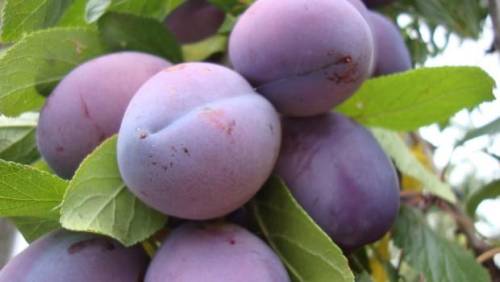

Published on April 28th, 2014 | Administrator
0
Plum began to be cultivated by the inhabitants of Egypt in the 5-6th century BC. In the 18th century, it was widespread in the southern regions of Russia. Today, this plant is still in demand among many gardeners. The fruit has many useful trace elements that have a positive effect on the human body. It is quite possible to grow this product at home for those who want to get irreplaceable benefits and taste. Background and description The gift of nature in question has become known in Russia since the 17th century. His first trees were planted in 1654 in the Moscow region. The plant began to be actively cultivated for industrial purposes in the next century. Plum belongs to the subfamily Pink (Plum, Almond). It grows in the form of a tree or a tall bush. The leaves are elliptical, with denticles at the edges. Blossoming pink, consisting of one or two to five buds. Fruit fleshy single-seeded oval-shaped drupe, the weight of which ranges from 6 to 10 grams. Its color can be yellow, red, bluish-black with a bluish tinge.
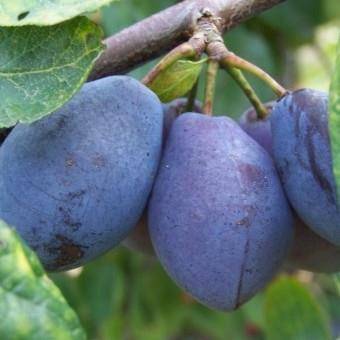

Why do you need to know plum varieties? There are different types of the plant in question. When choosing a variety, it is very important to pay attention to its frost resistance, because further fruiting depends on this factor. The following varieties have such qualities: • common and large-fruited thorn; • Sineglazka; • Fast-growing; • Tatar yellow; • Renklode Tenkovsky; • Early ripening red; • Volga beauty. Common blackthorn grows in the form of a bush with a height of 2-3 meters. The fruits are small. They contain many tannin microelements, thanks to which the taste of the plum improves after the autumn frost. In this plant, root shoots are formed in a radius of 2.5 to 3 meters around the bush. Large-fruited blackthorn is a shrub of medium height with a rounded top. Its fruits ripen by the end of September and are most often used for jam or compost. They reach a mass of 13 to 16 grams. This variety has a high yield. Another type of plum known to many gardeners is blue-eyed. A shrub with a wide crown at the end of August, bears a large number of small dark blue fruits. The advantage of the species is the minimal growth of overgrowth. For pollination, you will need special varieties, for example, thorns and Skorospelka red. The early-fruiting plum is a hybrid that begins to bear fruit already in the second or third year after vaccination. The drupes begin to sing in mid-August and are very juicy. The pollinator variety is Ussuriyskaya plum, Krasny Shar, Zarya, Sister Zarya and others. Tatar yellow - a type of plum shrub up to three meters in height with a branched crown.The plant blooms rather late, but it has high frost resistance and productivity. In August, it bears amber-yellow fruits.
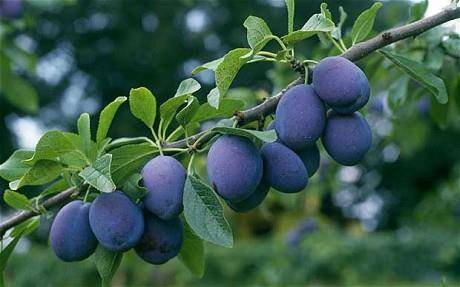

Renklod Tenkovsky is a high-yielding plum tree with a spreading crown, adapted for life in Tatarstan, Bashkortstan and in similar climatic conditions. Its advantage is resistance to parasites and various ailments. Fruits are orange-red with a light bloom ripen by mid-September. Pollinated by the following varieties: thorns, Skorospelka red, Eurasia 21. The early ripening red is a well-known variety of plum that ripens early. The plant reaches a height of up to three meters and bears small sweet and sour drupes of a violet-red hue. Frost resistance is above average. This variety has a high yield, which can be done even more when pollinated by other species: Vengerka, Rakitova, Kolkhoz Renklod and others. The Volga beauty is a plum tree with a spherical crown. It bears many large and juicy dark red fruits. The index for frost resistance is average. Useful properties of the hybrid Plum is a unique dietary low-calorie product that retains a lot of useful properties even after processing. The pulp contains trace elements that improve digestion and have a laxative effect. The product contains vitamins of group B, as well as A, PP and ascorbic acid, which strengthen blood vessels and have a positive effect on the visual organ. The drupe contains potassium and magnesium, which nourish the heart. Regular consumption of the fruit in question will prevent the appearance of cholesterol and cleanse the blood vessels. Experts advise including plums in the diet for people with high blood pressure, as well as those suffering from intestinal atony. It stimulates the creation of blood cells, so it is useful for anemia. It must be used for diseases of the kidneys, urinary system, metabolic disorders, rheumatism and as a prophylaxis against obesity. Plum is beneficial for athletes or individuals with an active lifestyle, as it has a positive effect on the contraction and training of muscles. The micronutrients contained in the product stimulate appetite, so the plum is useful for children with appetite disorders. The use of plums in folk medicine The beneficial properties of drupes are still actively used in non-traditional human treatment. 1. In case of intestinal atony or constipation, it is recommended to use compotes, or juices from fresh or dried fruits (preferably prunes). They have a mild laxative effect. 2. It is possible to speed up wound healing with the help of decoctions from dry and fresh leaves of the considered gift of nature. 3. In ancient folk medicine, the filaments on the trunk of a plum tree were used to fight ulcers, as well as to strengthen the organs of vision. 4. The product contains phytocoumarins, which can prevent the formation of blood clots in small vessels, expanding them and thinning the blood.
Contraindications Plum is a very useful product, but it must be used with caution, otherwise it will be harmful. It can cause diarrhea in children and adults, so do not eat a lot of drupe. The product is contraindicated in nursing mothers to avoid bloating and upset stomach in the baby.
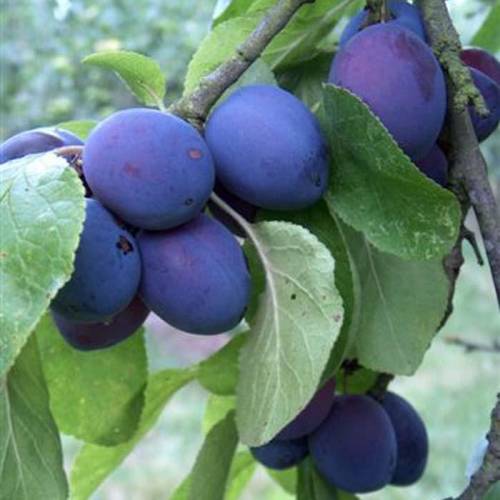

Reproduction There are different ways of breeding plums: • grafting; • separation of root growth; • green cuttings; • from a bone. For grafting, an important requirement must be fulfilled: the seedling chosen as the rootstock must be frost-resistant. In this case, the blackthorn or the Ussuri plum variety is perfect. The easiest way to reproduce is to remove the roots of the plum tree. Choose the largest seedlings farther from the mother plant. It is necessary to gradually prepare them for transplantation, then they will take root well.To do this, you need to slightly dig up the ground and find the main root. Then, using a shovel or an ax, the root system is separated from the mother plant. You can move the seedling only after two weeks. Before propagating plums by green cuttings, it is required to prepare a small greenhouse from film and soil. In the selected place, a hole is dug up to 40 cm deep, on the bottom of which pebbles are laid with a layer of up to 20 cm, then fertilized soil (15-20 cm), a mixture of peat and sand (in a ratio of 1: 1), lay 10 cm thick.Everything is carefully leveled and add a layer of coarse river sand (3-5 cm). The resulting substrate is lightly crushed with a board. When the bases of plum cuttings begin to redden and harden and their active growth slows down, they can be cut off. It is necessary to choose the largest of them, 25 to 30 cm long. In this case, it is desirable to have an abundance of fruit buds on them. Some varieties can be grown from seed, such as the early-fruited, which will yield a large harvest. This breeding method is carried out in the autumn. The seed is placed in a garden bed to a depth of 6-7 cm with a layer of mulched humus or compost (thickness from 2 to 4 cm). The sprout will appear in the spring. Peculiarities of plum cultivation In Russia, the most common are bushy drupes with a low crown. Favorable growth depends entirely on the degree of frost resistance of the variety. Plum suffers greatly in cold climates with a sharp temperature drop. It is destroyed by such a contrast as prolonged thaws that turn into severe frosts. For this reason it is very important to choose a type of plum that is resistant to cold conditions. Gardeners often face a problem: if all the subtleties of planting and care are observed, the plum blooms profusely, but does not bear fruit. The fact is that many of the hybrids are cross-pollinated, that is, they require a pollinator variety. The soil should be drained and well ventilated. It may include light loamy, sandy, chestnut soils. Plum grows well on black soil. For her, stagnation of water (especially in spring) and drought are extremely undesirable. How to plant a plum correctly? Spring is the most favorable period for planting the hybrid in question. In the fall, he does not have enough time for full rooting and strengthening, therefore, in the cold season, children in most cases freeze out. If it was possible to purchase seedlings at the end of summer, they are dug in and covered with pine branches, and at the beginning of the cold season with snow. In this case, the plum will handle the cold period well. When the snow melts, the plant is inspected for damage: broken branches, traces of rodents, and others. It should be removed from the hole just before planting. The best place for future plums is on the sunny side, where cold winds do not fall. It is advisable to place the plum on the south side relative to other tall trees (apple trees, pears), which should not create a shadow on it. The distance between the seedlings and the rows should be about 3 meters. The wells should be prepared two weeks before planting. Their depth is 45-50 cm, diameter is about 70 cm. The earth from the created hole must be mixed with humus in a 2: 1 ratio. When landing, a peg is driven into the center and a hole is covered with a part of the mixture so that a cone is formed. On the north side of the pillar, the seedling is placed in a strictly vertical position, and the roots are evenly laid out around the formed slide. Then carefully cover the plant with earth, shaking it slightly (to avoid the formation of voids) and then crush it with your hands.
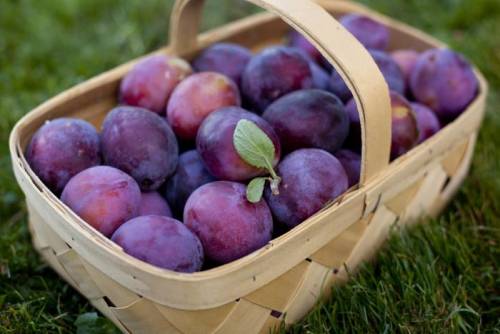

After planting, the bottom of the stem should be 3 to 5 cm above ground level. Its center must be carefully tied to the peg with a soft twine or cloth. Over time, the soil will settle and the root collar will reach the soil surface. Deeper location oppresses the plum, worsens its fruiting and growth. When it is planted, it is necessary to make a land side.Watering will require about three buckets of water per hybrid and soil mulching. Proper care and pest control Plum is very sensitive to soil moisture. Too dry soil during the formation of ovaries leads to their massive fall, and an excess of liquid leads to the appearance of diseases. For watering, experts recommend using water heated under the sun. The plant in question requires feeding from nitrogen, potassium, magnesium and phosphorus. After the first flowering, tinctures from bird droppings or mullein are ideal. Two years after the growth, the plum begins to branch profusely in the lower part of the trunk, therefore pruning is required. It should be done exactly when the plant is green, then it will better tolerate processing. It is necessary to remove the shoots so that the branching becomes uniform throughout the crown. They should be removed from the trunk of the plum, root growth. Twigs directed inward or close and parallel to each other are superfluous for the tree. In order for the yield of plums to be at the maximum level, it is necessary to regularly remove the root shoots on which it spends its resources. This must be done 4 times during the summer season, otherwise the plant will greatly weaken, and aphids will appear on young sprouts. The hybrid in question is susceptible to the influence of pests such as the plum moth. This parasite resembles the codling moth, but its larvae are smaller and red in color. The most effective way to combat it is by spraying with appropriate products. The first procedure should be carried out at the end of May, and the last one a month or more before harvesting. Frequency - once every two weeks. Knowing all the features of plum cultivation at home, even a novice gardener will be able to grow this useful and very tasty plant in his garden.

